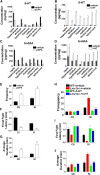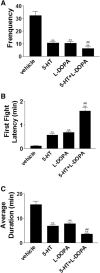Enhancement of Aggression Induced by Isolation Rearing is Associated with a Lack of Central Serotonin
- PMID: 30977041
- PMCID: PMC6754493
- DOI: 10.1007/s12264-019-00373-w
Enhancement of Aggression Induced by Isolation Rearing is Associated with a Lack of Central Serotonin
Abstract
Isolation rearing (IR) enhances aggressive behavior, and the central serotonin (5-hydroxytryptamine, 5-HT) system has been linked to IR-induced aggression. However, whether the alteration of central serotonin is the cause or consequence of enhanced aggression is still unknown. In the present study, using mice deficient in central serotonin Tph2-/- and Lmx1b-/-, we examined the association between central serotonin and aggression with or without social isolation. We demonstrated that central serotonergic neurons are critical for the enhanced aggression after IR. 5-HT depletion in wild-type mice increased aggression. On the other hand, application of 5-HT in Lmx1b-/- mice inhibited the enhancement of aggression under social isolation conditions. Dopamine was downregulated in Lmx1b-/- mice. Similar to 5-HT, L-DOPA decreased aggression in Lmx1b-/- mice. Our results link the serotoninergic system directly to aggression and this may have clinical implications for aggression-related human conditions.
Keywords: 5-HT; Aggression; Dopamine; Lmx1b; Social isolation.
Conflict of interest statement
The authors declare no actual or potential conflicts of interest including any financial, personal or other relationships with other people or organizations within three years of beginning the work submitted that could inappropriately influence (bias) their work.
Figures





References
MeSH terms
Substances
LinkOut - more resources
Full Text Sources

